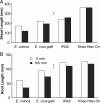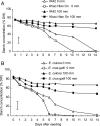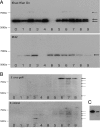Differences in responses to flooding by germinating seeds of two contrasting rice cultivars and two species of economically important grass weeds
- PMID: 25336336
- PMCID: PMC4243074
- DOI: 10.1093/aobpla/plu064
Differences in responses to flooding by germinating seeds of two contrasting rice cultivars and two species of economically important grass weeds
Abstract
Crop productivity is largely affected by abiotic factors such as flooding and by biotic factors such as weeds. Although flooding after direct seeding of rice helps suppress weeds, it also can adversely affects germination and growth of rice, resulting in poor crop establishment. Barnyard grasses (Echinochloa spp.) are among the most widespread weeds affecting rice, especially under direct seeding. The present work aimed to establish effective management options to control these weeds. We assessed the effects of variable depths and time of submergence on germination, seedling growth and carbohydrate metabolism of (i) two cultivars of rice known to differ in their tolerance to flooding during germination and (ii) two barnyard grasses (Echinochloa colona and E. crus-galli) that commonly infest rice fields. Flooding barnyard grasses with 100-mm-deep water immediately after seeding was effective in suppressing germination and growth. Echinochloa colona showed greater reductions in emergence, shoot and root growth than E. crus-galli. Delaying flooding for 2 or 4 days was less injurious to both species. Echinochloa colona was also more susceptible to flooding than the flood-sensitive rice cultivar 'IR42'. The activity of alcohol dehydrogenase (ADH) and pyruvate decarboxylase (PDC) in rice seedlings was increased by flooding after sowing but with greater increases in 'Khao Hlan On' compared with 'IR42'. The activity of ADH and PDC was enhanced to a similar extent in both barnyard grasses. Under aerobic conditions, the activity of ADH and PDC in the two barnyard grasses was downregulated, which might contribute to their inherently faster growth compared with rice. Aldehyde dehydrogenase activity was significantly enhanced in flood-tolerant 'Khao Hlan On' and E. crus-galli, but did not increase in flood-sensitive E. colona and 'IR42', implying a greater ability of the flood-tolerant types to detoxify acetaldehyde generated during anaerobic fermentation. Confirmation of this hypothesis is now being sought.
Keywords: Alcohol dehydrogenase; Echinochloa colona; Echinochloa crus-galli; aldehyde dehydrogenase; anaerobic germination; barnyard grass; direct-seeded rice; fermentative metabolism; pyruvate decarboxylase; rice weeds..
Published by Oxford University Press on behalf of the Annals of Botany Company.
Figures








References
-
- Angaji S, Septiningsih EM, Mackill DJ, Ismail AM. QTLs associated with tolerance of anaerobic conditions during germination in rice (Oryza sativa L.) Euphytica. 2010;172:159–168. doi: 10.1007/s10681-009-0014-5. - DOI
-
- Bradford M. A rapid and sensitive method for the quantitation of microgram quantities of protein utilizing the principle of protein-dye binding. Analytical Chemistry. 1976;72:248–254. - PubMed
-
- Chauhan BS. Can knowledge in seed ecology contribute to improved weed management in direct-seeded rice? Current Science. 2012;103:486–489.
-
- Chauhan BS, Johnson DE. Ecological studies on Echinochloa crus-galli and the implications for weed management in direct-seeded rice. Crop Protection. 2011;30:1385–1391.
-
- Chauhan BS, Pame ARP, Johnson DE. Compensatory growth of ludwigia (Ludwigia hyssopifolia) in response to interference of direct-seeded rice. Weed Science. 2011;59:177–181.
LinkOut - more resources
Full Text Sources
Other Literature Sources
Miscellaneous

